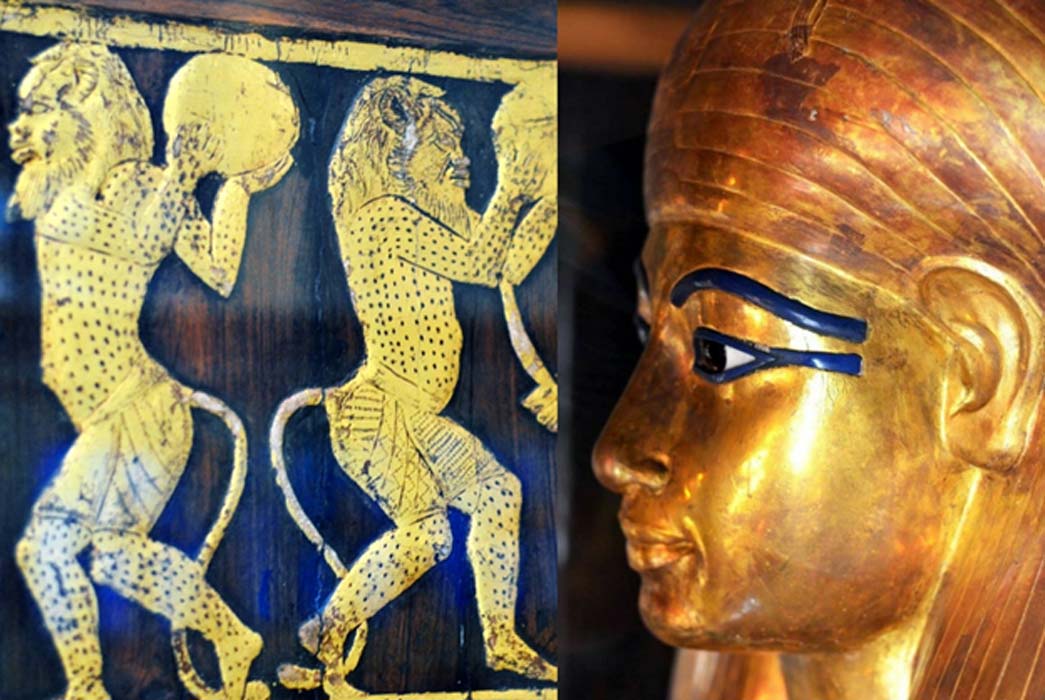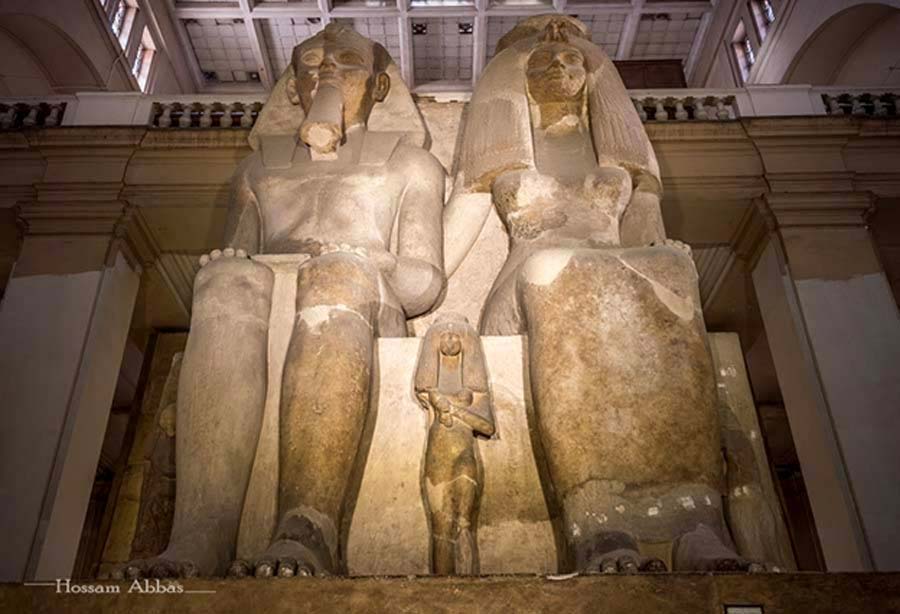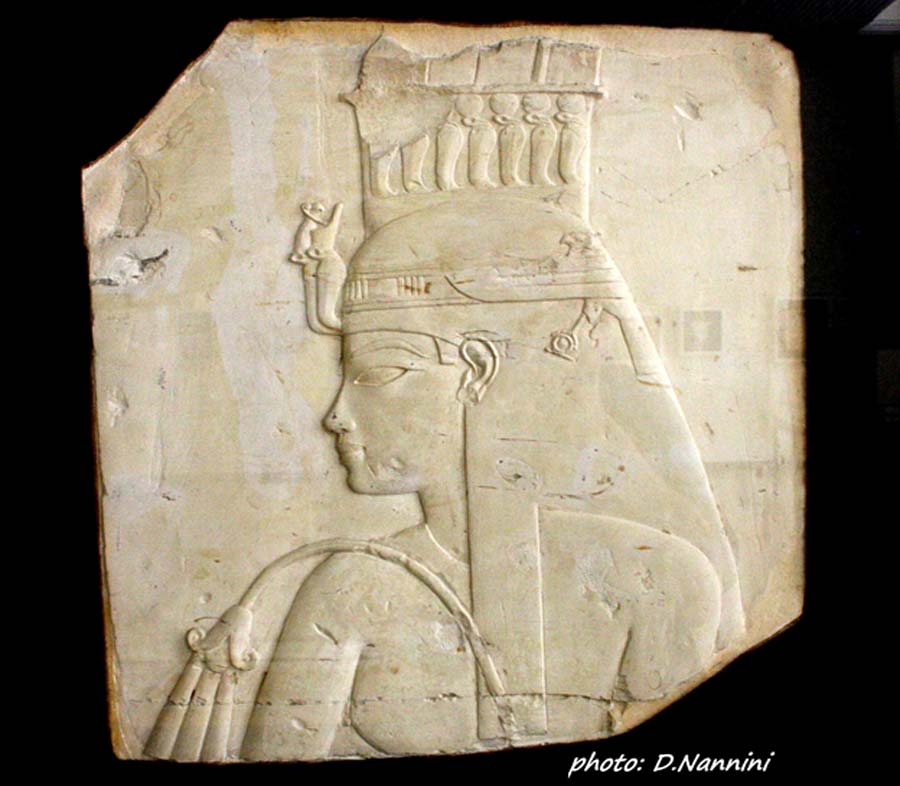
Bedazzling Treasures of Yuya and Tjuyu: K46 and the Golden Road to Nobility – Part I
Queen Tiye stands head and shoulders above all the Great Royal Wives of ancient Egypt. Though it is said that her background was that of a commoner, she rose to prominence mainly due to her resourceful parents, Yuya and Tjuyu. Persons of obviously no mean ability, the combined efforts of these two nobles ensured that Egypt enjoyed a time of unprecedented prosperity during the reign of their son-in-law, Amenhotep III.

The colossal limestone group statue of Amenhotep III, Queen Tiye and their daughters – Henuttaneb, the largest and best preserved, in the center; Nebetah on the right; and another, whose name is destroyed. The sculpture rises seven meters in height dwarfing all other statues in the central hall of the Egyptian Museum, Cairo. This monolith originated from Medinet Habu in Western Thebes.
Queen Tiye (circa 1398 – 1338 BC) whom the Sun King Amenhotep III wedded when he ascended the throne as a 12-year-old, was the jewel in his crown. Soon after their marriage, the pharaoh exalted his spouse to the position of Great Royal Wife; an honor that was denied even to his beloved mother, Mutemwiya. This sent a strong message that Tiye superseded the king’s own mother – if one took into account the fact that she is portrayed only in his artworks and monuments - for instance the Colossi of Memnon group statue - and not in those of her husband, Thutmose IV. So, what was the background of the new queen, whom Amenhotep was so clearly smitten by?

This fragment from the tomb of Userhat (TT47) at Thebes depicts Queen Tiye seated in a kiosk with her husband, King Amenhotep III. This exquisite portrait was stolen from the tomb, and, after sustaining damage, found its way to the Brussels Royal Museum.
The Advent of Queen Tiye
“A statue of the treasurer Sobekhotep holding a prince Amenhotep-merkhepesh probably shows the king shortly before his father's death, and a wall painting in the tomb of the royal nurse Hekarnehhe (TT 64) describes the tomb-owner as the royal nurse of Prince Amenhotep, portraying the prince as a youth rather than a small naked child. The age of the king at accession could have been anywhere between 2 and 12, with a later age perhaps to be preferred given that Amenhotep's mother, Mutemwiya, was barely more visible than Tiaa and Merytra, the preceding two kings' mothers. A regency by Mutemwiya appears unlikely, and, if the king was indeed a small child at accession, his rule was conducted for him quite unobtrusively. An alternative possibility might be that members of Queen Tiye's family assisted the king in his early rule. A scarab dated in year 2 of Amenhotep's reign established the early date of his marriage to Tiye, and the identification on another scarab of the queen's parents, Yuya and Tuya, underscores their prominence. There is, at present, no documentary evidence that Tiye's family acted as a power behind the throne,” explains Ian Shaw.

This facsimile painting copies the focal point of an offering scene in the tomb of an unknown official (TT 226) at Thebes. It represents Amenhotep III enthroned beneath a kiosk. His mother, Mutemwiya, stands behind him. Beneath the kiosk is a row of foreigners from Nubia and western Asia who praise the king with upraised arms. Nina de Garis Davies. Metropolitan Museum of Art, New York.
One of the first glimpses the ancient world got of Queen Tiye was from the commemorative ‘Marriage scarabs’ issued by Amenhotep III at the beginning of his reign; in which the sovereign proudly proclaimed: “I have taken a wife, the chief queen Tiye, Mistress of the Two Lands. Her parents are Yuya and Tjuyu. She is the wife of a mighty king.” However, Tiye was not of royal stock, but the daughter of a chariot officer whose family hailed from an Upper Egyptian town. “Tiye came from the powerful Akhmim clan, a veritable cat’s cradle of interconnectedness and clout. Mutemwiya, wife of Thutmose IV and Amenhotep III’s mother, was in all probability Tiye’s sister, and it now seems likely that she engineered the marriage of Tiye and Amenhotep, which unleashed an avalanche of history,” reveals Egyptological scholar, Brian Alm.




